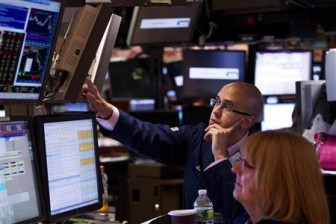NEW YORK, (Reuters) – U.S. stocks closed out their worst week in more than two years today in a volatile session that saw the major indexes whip back and forth before the S&P 500 ended down less than a point.
More than 15.9 billion shares — or more than twice the daily average volume — traded in the busiest day in more than a year as investors plowed into cash-rich mega-cap stocks that had been beaten down in recent days as the market dropped.
The market’s swings today were fast and furious, with the Dow Jones industrial average covering 416.41 points from its session high to its intraday low.
The intense selling this week reflects frustration with sluggish economic growth and politicians’ inability to address pressing concerns over high public debt in Europe and the United States.

Options volume hit a record, a sign investors were protecting their portfolios from further declines. The CBOE Volatility Index or VIX, Wall Street’s so-called fear gauge, rose as high as 39.25 earlier, its highest level since May 2010, but ended at 32, up 1.1 percent.
“Still, the volatility index is up almost 90 percent during the past two weeks, as fears about the European debt crisis, the global economy and earnings have taken a heavy toll on investor sentiment,” said Joe Cusick, senior market analyst at online brokerage optionsXpress in Chicago.
The S&P 500 is now down 12 percent from its April 29 closing high.
Markets have been looking to European officials for guidance as to how the region’s debt crisis will be managed. Part of the loss of confidence stemmed from what investors called an inadequate response to the growing threat to large euro-zone economies Spain and Italy and banks’ exposure to their troubled debt.
In the United States, non-farm payrolls data showed a gain of 117,000 jobs in July compared with a forecast for an increase of 85,000, while the country’s unemployment rate dipped to 9.1 percent last month from 9.2 percent in June, the Labor Department reported.
The Dow Jones industrial average rose 60.93 points, or 0.54 percent, to end at 11,444.61. But the Standard & Poor’s 500 Index edged down just 0.69 of a point, or 0.06 percent, to finish at 1,199.38. The Nasdaq Composite Index slipped 23.98 points, or 0.94 percent, to close at 2,532.41.
On the New York Stock Exchange, decliners beat advancers by a ratio of about 3 to 1, while on the Nasdaq, more than two stocks fell for every one that rose.
For the week, the Dow fell 5.8 percent, the S&P 500 was down 7.2 percent and the Nasdaq was off 8.1 percent.
Among individual stocks, Bank of America and Citigroupcontinued their declines, with both stocks hitting a new 52-week low.
Bank of America shares fell 7.5 percent to $8.17, off a 52-week low at $8.03, and Citigroup dropped 3.9 percent to $33.44, off a 52-week low at $31.81.
Italian Prime Minister Silvio Berlusconi said his country will introduce a constitutional principle of a balanced budget in an effort to reduce debt levels.
Helping the market erase hefty losses in afternoon trade, sources said the European Central Bank was ready to buy Italian and Spanish bonds if Berlusconi commits to bringing forward specific reforms.
Exchange-traded funds tracking Italian and Spanish stocks rose. The iShares MSCI Italy Index jumped 5.5 percent, while the iShares MSCI Spanish Index advanced 6.5 percent.
But a possible S&P downgrade of U.S. debt after the market close pressured stocks throughout the day.
The recent steep sell-off has put all three major indexes in negative territory for the year.
On Friday, Credit Suisse reduced its year-end view of the S&P 500 to 1,350 from 1,450, citing weaker-than-expected growth.





